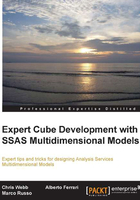
Preface
Microsoft SQL Server Analysis Services ("Analysis Services" from here on) is now 15 years old, and a mature product proven in thousands of enterprise-level deployments around the world. Starting from a point where few people knew that Analysis Services existed and those who knew about it were often suspicious of it, it has grown to be the most widely deployed OLAP server and one of the keystones of Microsoft's Business Intelligence product strategy. Part of the reason for its success has been the easy availability of information about it. Apart from the documentation Microsoft provides, there are white papers, blogs, online forums, and books galore on the subject. So, why should we write yet another book on Analysis Services? The short answer is to bring together all of the practical, real-world knowledge about Analysis Services that's out there into one place.
We, the authors of this book, are consultants who have spent the last few years of our professional lives designing and building solutions based on the Microsoft Business Intelligence platform and helping other people to do so. We've watched Analysis Services growing to its maturity and at the same time seen more and more people moving from being hesitant beginners on their first project to confident cube designers; but, at the same time, we felt that there were no books on the market aimed at this emerging group of intermediate-to-experienced users. Similarly, all of the Analysis Services books we read concerned themselves with describing its functionality and what you could potentially do with it, but none of them addressed the practical problems that we encountered day-to-day in our work—the problems of how you should go about designing cubes, what the best practices for doing so are, which areas of functionality work well and which don't, and so on. We wanted to write this book to fill these two gaps, and to allow us to share our hard-won experience. Most of the technical books are published to coincide with the release of a new version of a product and so are written using beta software, before the author had a chance to use the new version in a real project. This book, on the other hand, has been written with the benefit of having used Analysis Services for many years.
A very important point to make is that this book only covers Analysis Services 2012 Multidimensional Models. As you may know, as of SQL Server 2012, there are two versions of Analysis Services: Multidimensional and Tabular. Although both of them are called Analysis Services and can be used for much the same purposes, the development experience for the two is completely different. If you are working on a Microsoft Business Intelligence project, it is very likely that you will be using either one or the other, not both, so it makes no sense to try and cover both Multidimensional and Tabular in the same book.
The approach we've taken with this book is to follow the lifecycle of building an Analysis Services solution from start to finish. As we've said already, this does not take the form of a basic tutorial; it is more of a guided tour through the process with an informed commentary telling you what to do, what not to do, and what to look out for.
Another important point must be made before we continue and it is that in this book we're going to be expressing some strong opinions. We're going to tell you how we like to design cubes based on what we've found to work for us over the years, and you may not agree with some of the things that we say. We're not going to pretend that all of the advice that differs from our own is necessarily wrong, though: best practices are often subjective and one of the advantages of a book with multiple authors is that you not only get the benefit of more than one person's experience but also that each author's opinions have already been moderated by his or her co-authors. Think of this book as a written version of the kind of discussion you might have with someone at a user group meeting or a conference, where you pick up hints and tips from your peers. Some of the information may not be relevant to what you do, some of it you may dismiss, but even if only 10 percent of what you learn is new, it might be the crucial piece of knowledge that makes the difference between the success and failure of your project.
Analysis Services is very easy to use—some would say too easy. It's possible to get something up and running very quickly and as a result, it's an all too common occurrence that a cube gets put into production and subsequently shows itself to have problems that can't be fixed without a complete redesign. We hope that this book helps you to avoid having an "If only I'd known about this earlier!" moment yourself, by passing on the knowledge that we've learned the hard way. We also hope that you will enjoy reading it and that you're successful in whatever you're trying to achieve with Analysis Services.